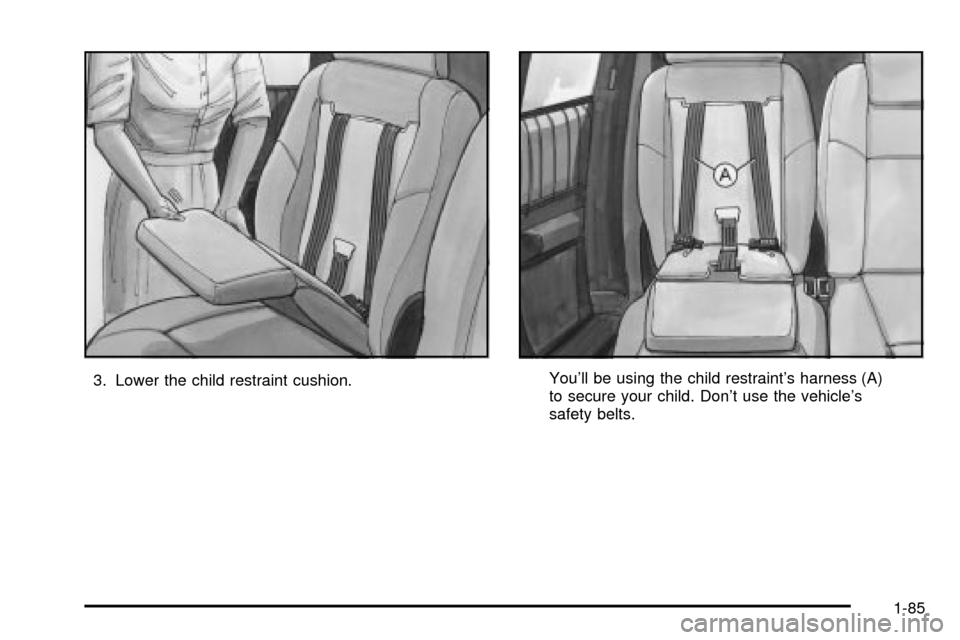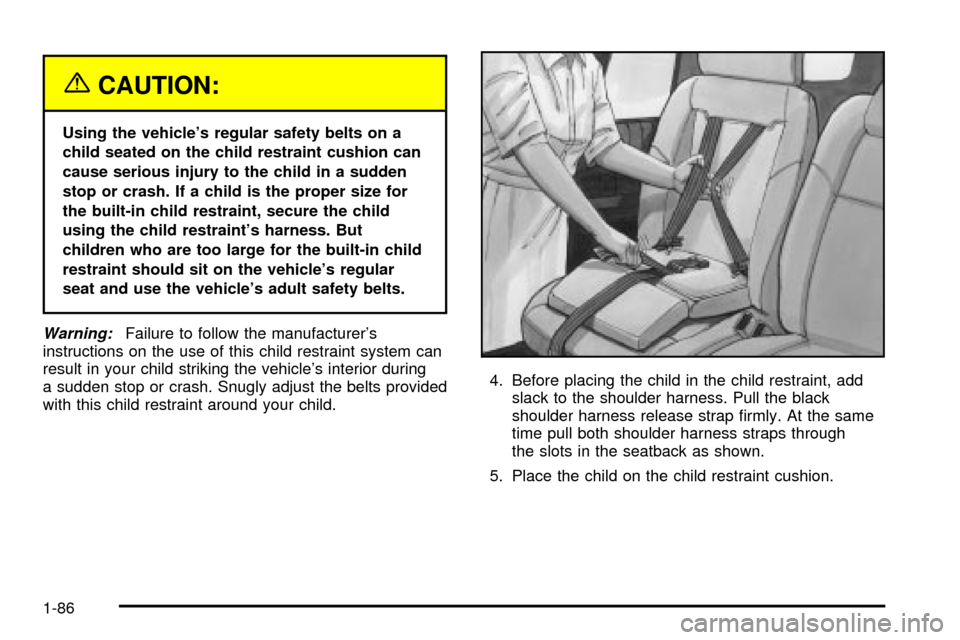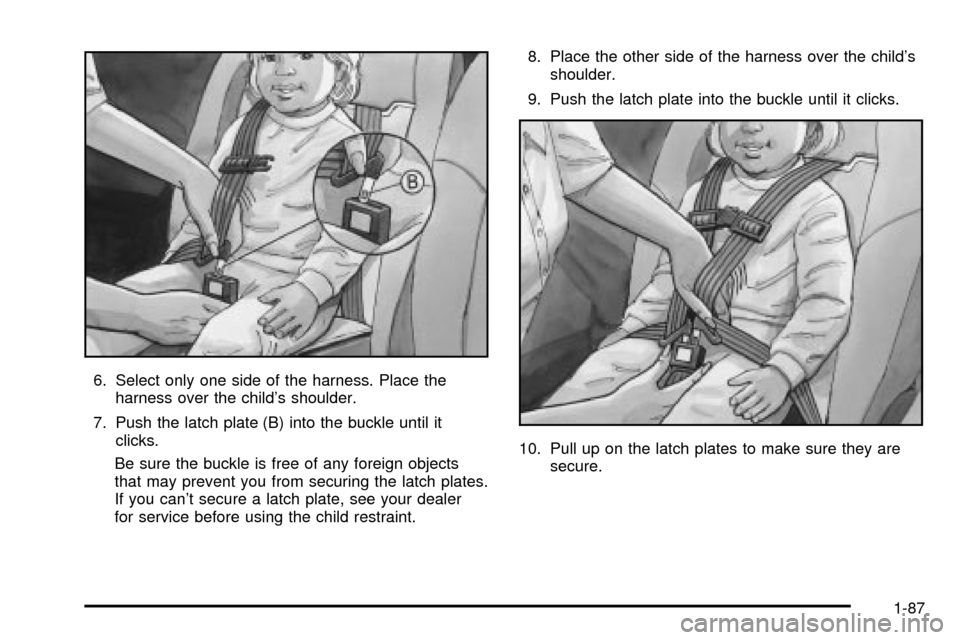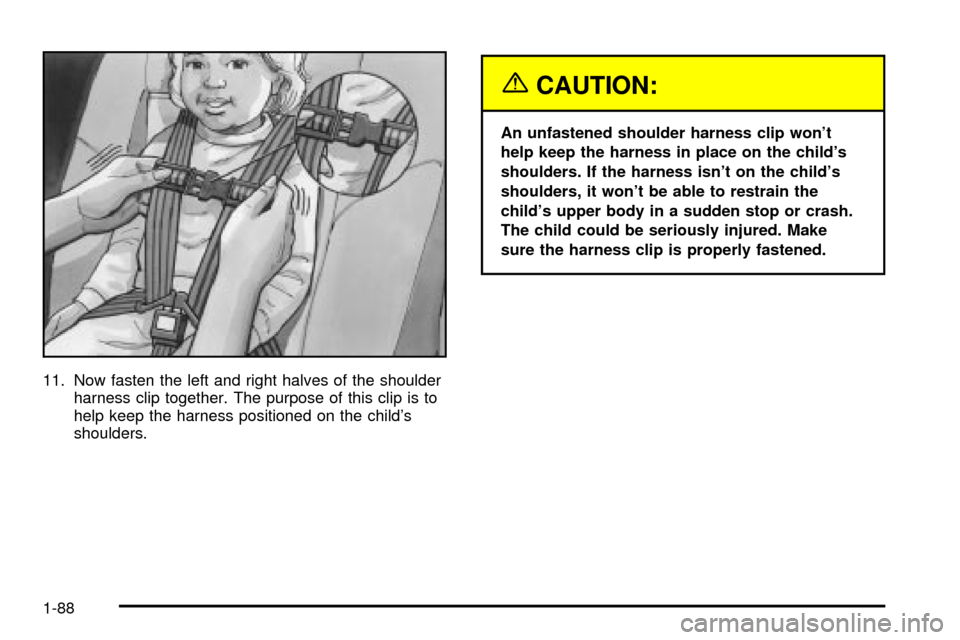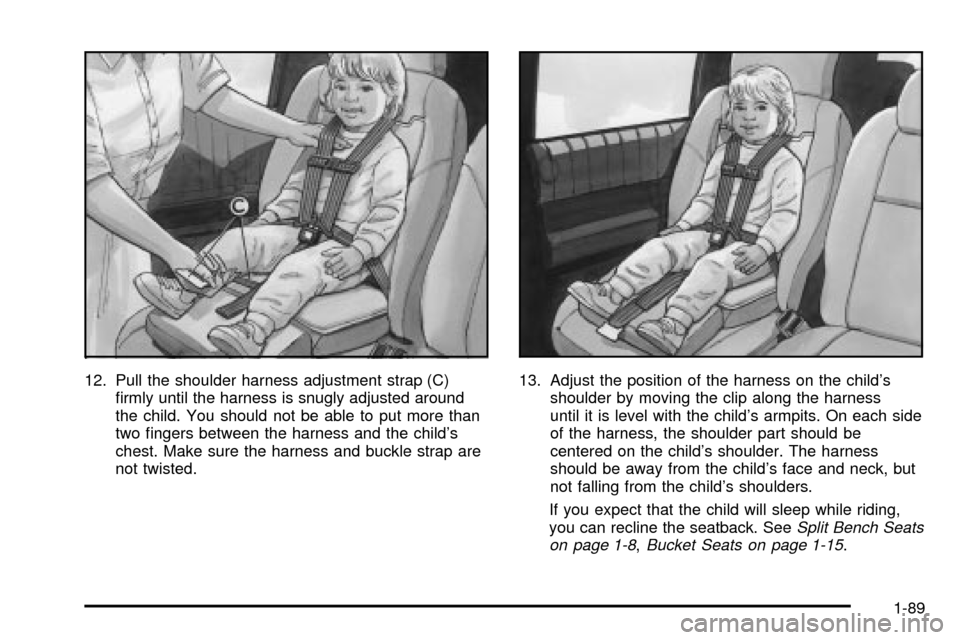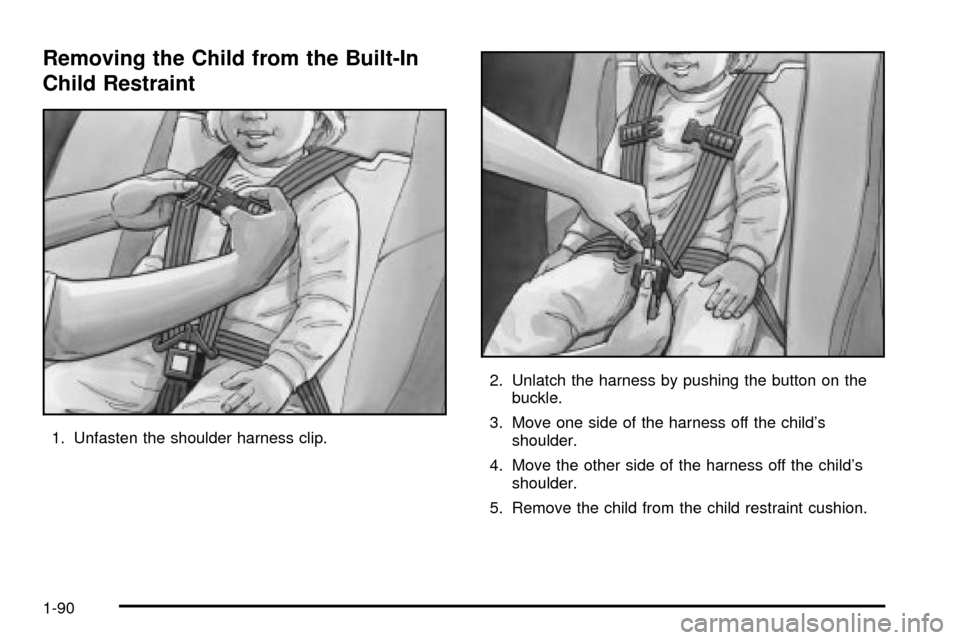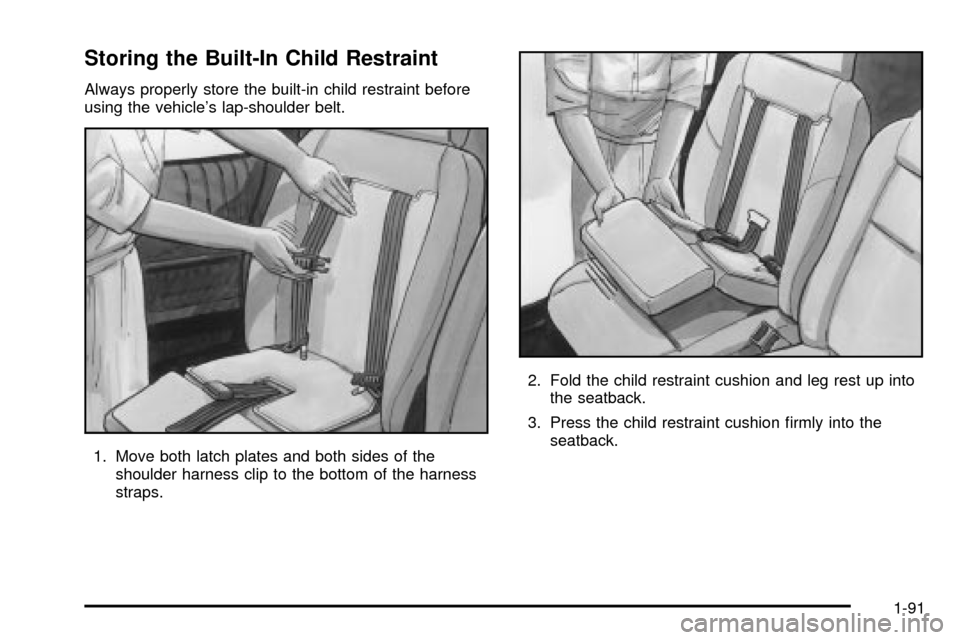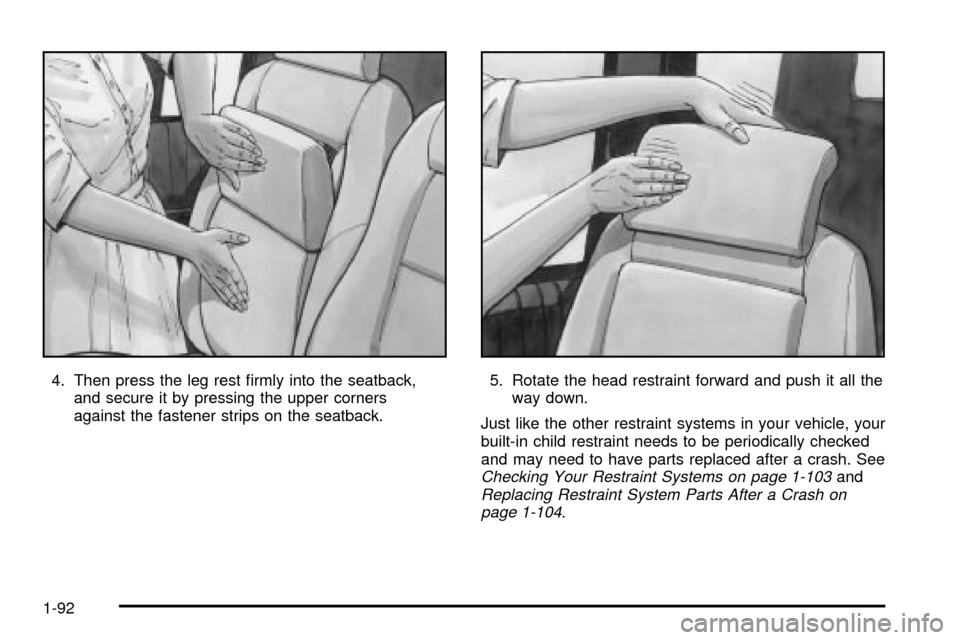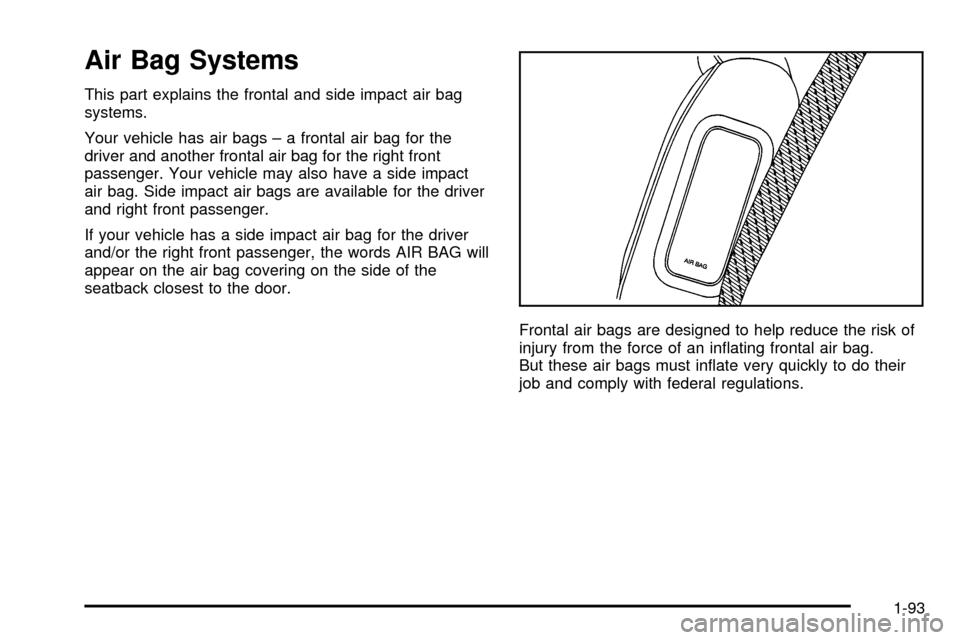CHEVROLET VENTURE 2003 1.G Owners Manual
VENTURE 2003 1.G
CHEVROLET
CHEVROLET
https://www.carmanualsonline.info/img/24/8380/w960_8380-0.png
CHEVROLET VENTURE 2003 1.G Owners Manual
Trending: reset, wiper blades, flat tire, tow, engine coolant, service, radiator cap
Page 91 of 486
3. Lower the child restraint cushion.You'll be using the child restraint's harness (A)
to secure your child. Don't use the vehicle's
safety belts.
1-85
Page 92 of 486
{CAUTION:
Using the vehicle's regular safety belts on a
child seated on the child restraint cushion can
cause serious injury to the child in a sudden
stop or crash. If a child is the proper size for
the built-in child restraint, secure the child
using the child restraint's harness. But
children who are too large for the built-in child
restraint should sit on the vehicle's regular
seat and use the vehicle's adult safety belts.
Warning:Failure to follow the manufacturer's
instructions on the use of this child restraint system can
result in your child striking the vehicle's interior during
a sudden stop or crash. Snugly adjust the belts provided
with this child restraint around your child.4. Before placing the child in the child restraint, add
slack to the shoulder harness. Pull the black
shoulder harness release strap ®rmly. At the same
time pull both shoulder harness straps through
the slots in the seatback as shown.
5. Place the child on the child restraint cushion.
1-86
Page 93 of 486
6. Select only one side of the harness. Place the
harness over the child's shoulder.
7. Push the latch plate (B) into the buckle until it
clicks.
Be sure the buckle is free of any foreign objects
that may prevent you from securing the latch plates.
If you can't secure a latch plate, see your dealer
for service before using the child restraint.8. Place the other side of the harness over the child's
shoulder.
9. Push the latch plate into the buckle until it clicks.
10. Pull up on the latch plates to make sure they are
secure.
1-87
Page 94 of 486
11. Now fasten the left and right halves of the shoulder
harness clip together. The purpose of this clip is to
help keep the harness positioned on the child's
shoulders.
{CAUTION:
An unfastened shoulder harness clip won't
help keep the harness in place on the child's
shoulders. If the harness isn't on the child's
shoulders, it won't be able to restrain the
child's upper body in a sudden stop or crash.
The child could be seriously injured. Make
sure the harness clip is properly fastened.
1-88
Page 95 of 486
12. Pull the shoulder harness adjustment strap (C)
®rmly until the harness is snugly adjusted around
the child. You should not be able to put more than
two ®ngers between the harness and the child's
chest. Make sure the harness and buckle strap are
not twisted.13. Adjust the position of the harness on the child's
shoulder by moving the clip along the harness
until it is level with the child's armpits. On each side
of the harness, the shoulder part should be
centered on the child's shoulder. The harness
should be away from the child's face and neck, but
not falling from the child's shoulders.
If you expect that the child will sleep while riding,
you can recline the seatback. See
Split Bench Seats
on page 1-8,Bucket Seats on page 1-15.
1-89
Page 96 of 486
Removing the Child from the Built-In
Child Restraint
1. Unfasten the shoulder harness clip.2. Unlatch the harness by pushing the button on the
buckle.
3. Move one side of the harness off the child's
shoulder.
4. Move the other side of the harness off the child's
shoulder.
5. Remove the child from the child restraint cushion.
1-90
Page 97 of 486
Storing the Built-In Child Restraint
Always properly store the built-in child restraint before
using the vehicle's lap-shoulder belt.
1. Move both latch plates and both sides of the
shoulder harness clip to the bottom of the harness
straps.2. Fold the child restraint cushion and leg rest up into
the seatback.
3. Press the child restraint cushion ®rmly into the
seatback.
1-91
Page 98 of 486
4. Then press the leg rest ®rmly into the seatback,
and secure it by pressing the upper corners
against the fastener strips on the seatback.5. Rotate the head restraint forward and push it all the
way down.
Just like the other restraint systems in your vehicle, your
built-in child restraint needs to be periodically checked
and may need to have parts replaced after a crash. See
Checking Your Restraint Systems on page 1-103andReplacing Restraint System Parts After a Crash on
page 1-104.
1-92
Page 99 of 486
Air Bag Systems
This part explains the frontal and side impact air bag
systems.
Your vehicle has air bags ± a frontal air bag for the
driver and another frontal air bag for the right front
passenger. Your vehicle may also have a side impact
air bag. Side impact air bags are available for the driver
and right front passenger.
If your vehicle has a side impact air bag for the driver
and/or the right front passenger, the words AIR BAG will
appear on the air bag covering on the side of the
seatback closest to the door.
Frontal air bags are designed to help reduce the risk of
injury from the force of an in¯ating frontal air bag.
But these air bags must in¯ate very quickly to do their
job and comply with federal regulations.
1-93
Page 100 of 486
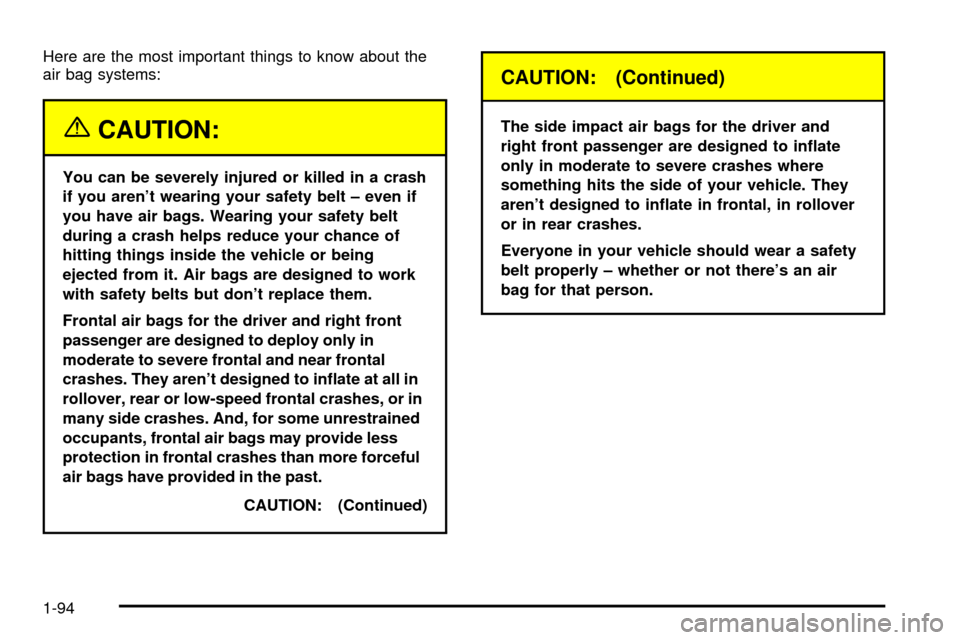
Here are the most important things to know about the
air bag systems:
{CAUTION:
You can be severely injured or killed in a crash
if you aren't wearing your safety belt ± even if
you have air bags. Wearing your safety belt
during a crash helps reduce your chance of
hitting things inside the vehicle or being
ejected from it. Air bags are designed to work
with safety belts but don't replace them.
Frontal air bags for the driver and right front
passenger are designed to deploy only in
moderate to severe frontal and near frontal
crashes. They aren't designed to in¯ate at all in
rollover, rear or low-speed frontal crashes, or in
many side crashes. And, for some unrestrained
occupants, frontal air bags may provide less
protection in frontal crashes than more forceful
air bags have provided in the past.
CAUTION: (Continued)
CAUTION: (Continued)
The side impact air bags for the driver and
right front passenger are designed to in¯ate
only in moderate to severe crashes where
something hits the side of your vehicle. They
aren't designed to in¯ate in frontal, in rollover
or in rear crashes.
Everyone in your vehicle should wear a safety
belt properly ± whether or not there's an air
bag for that person.
1-94
Trending: wiring, maintenance reset, ESP, dead battery, tire pressure, keyless, torque
